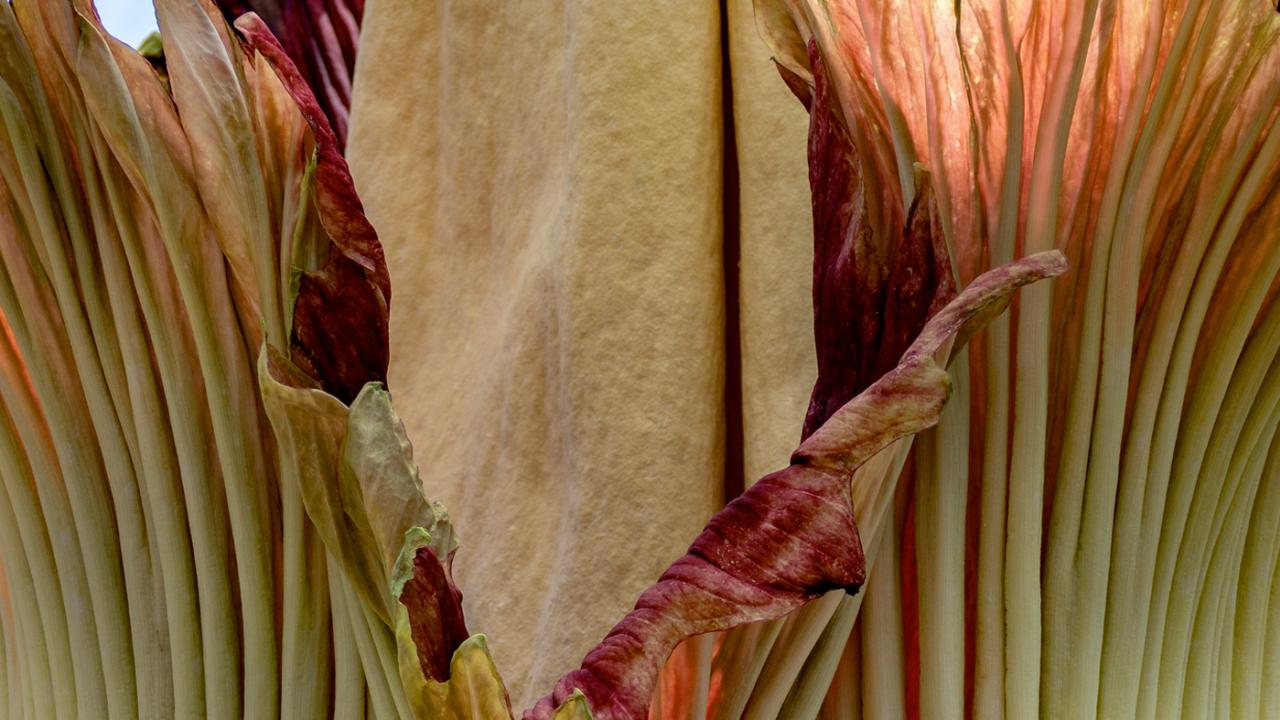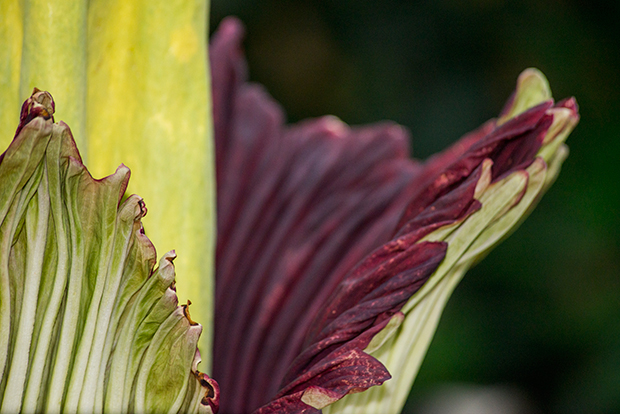
About Titan Arum
About the Corpse Flower
Amorphophallus titanum

Titan arums are huge.
The titan arum in bloom looks like a 6- to 8-foot-tall flower, but it’s actually a tall spadix (flower structure) wrapped by a spathe (a frilly modified leaf). Technically the largest unbranched inflorescence in the world, the titan arum also sends up tall, umbrella-like, individual leaves that can reach 15 feet and look like small trees.
It’s huge underground, too: leaves and flowers are powered by the largest known corm (a type of tuber) in the world. To bloom, the arum's corm gets bigger than a beach ball—some have been known to reach more than 200 pounds.
Titan arums are rare.
Titan arums don’t flower often—whether in the wild or at botanic gardens.
A native of the equatorial rainforests on the island of Sumatra (in the Indonesian archipelago), Amorphophallus titanum takes its time to grow before blooming—often ten years or more. Each year, the corm sends up a leaf to absorb energy from the sun. Finally the corm has enough energy stored to send up a flower bud and try to reproduce, and it’s worth the wait: an utterly thrilling visual phenomenon.
The titan arum bloom cycle is unpredictable.
At first, even the experts don’t know if what’s emerging is a leaf or a flower bud. Days must pass before the subtle signs—a more dimpled shape, a suggestion of a frill—point to flowering. Soon the plant is powering up, growing 4 to 6 inches per day, and the spiky spadix can be seen rising from the ruffly spathe.
About two weeks into the process, growth slows, and the spathe begins to unfurl. Without warning, on a schedule of its own, the big event has begun.

Titan arums smell awful.
Like many flowering plants, the titan arum uses scent to attract pollinators when it’s ready to reproduce.
Unlike most flowering plants, the arum has tremendous energy reserves that allow it to blast out its scent in one big, hours-long burst.
And the smell! The Indonesian name for the plant translates as “corpse flower,” an apt summary of the decaying, rancid, rotten stench. However, what smells horrid to humans is a magnet for the carrion beetles and flesh flies that are the titan arum’s natural pollinators.
The Big Night
The titan arum bloom cycle is fast, often beginning in midafternoon one day, and ending 24 to 36 hours later. As the spathe opens, the true female flowers at the base of the spadix signal their readiness for fertilization by releasing scent molecules. Internal heat volatilizes the molecules (turning them to vapor), and the resulting blast of stench alerts pollinators up to an acre away that the big night has begun. As the clock ticks off the hours, the spathe fully unveils its internal, deep maroon color—a meaty hue favored by the beetles and flies now crawling in, flying in, and gathering at the base of the “vase.”
Bustling about in the female flowers for the rotting flesh they want to lay their eggs on (hatching larvae feed on animal remains), the insects deposit pollen carried in on their backs and bodies from the last flower they visited—thereby completing the act of pollination that the entire evening is about.
By daybreak, the window of pollination opportunity is over, and the smell dissipates. Now it’s the male flowers’ turn to open, shedding fresh pollen on to the insects trapped inside. (Scientists think they’re trapped—research continues.) As the day goes by, the spathe closes and the entire inflorescence begins to crumple, setting the insects free and protecting the (hopefully) pollinated flowers inside.
Our team has been nurturing titan arums since 2003.
Over time, our family of titans has grown. Many of the Garden’s corpse flowers share the same lineage, and the Garden decided to share some of our titan wealth with other botanical institutions. It is important to build genetic diversity in our collection and at other botanical institutions. To learn more about our corpse flower sharing adventures read on and check out the map below.


